(c) Joanne Mattera www.joannemattera.com
My favorite piece at the Scope fair was about Nothing. Not a Seinfeldian nothing but an elegant installation by Joseph Havel at Dallas's Dunn and Brown booth composed of hundreds (thousands?) of custom-embroidered shirt labels pinned to the wall.

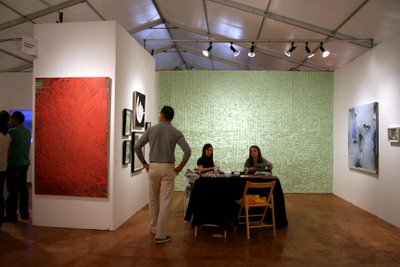
The red Sam Reveles painting on the wall to the left was the perfect complement, not only chromatically but conceptually, as energetically sensuous as "Nothing" was formally cool.
 Then there was the grid installation, about three feet square, composed of black sheetrock screws and red dots. Oops. This one really IS about nothing. Whatever was there had been taken off the wall (sold, presumably). I shot the grid moments before the gallery personnel moved in to remove the screws.
Then there was the grid installation, about three feet square, composed of black sheetrock screws and red dots. Oops. This one really IS about nothing. Whatever was there had been taken off the wall (sold, presumably). I shot the grid moments before the gallery personnel moved in to remove the screws.
Really about nothing: What's left after the work comes off the wall

At Las Vegas's Dust Gallery, I saw the pristinely reductive work of Marietta Hoferer. You can’t see this work too well in the installation shot below, so I’ve pulled an image from the artist's website. What you’re looking at is a work on paper composed of meticulously cut and placed strapping tape on paper. Such elegance from workaday material.

At Dust Gallery: An installation of six reductive works by Marietta Hoferer, all strapping tape on paper, with a related work below

Continuing with the elegantly minimal, I loved the work of Frank Gerritz at Pablo’s Birthday. Gerritz paints bands of dark color on thick sheets of steel. The brushstrokes are visible, a sensuous texture against the cool, milled metal. Gerritz just might be the lovechild of Richard Serra and Agnes Martin. Clicking this New York gallery’s link on the Scope website just kept looping back to Scope, so if you wish to see more, Google Frank Gerritz.

Frank Gerritz: Oil on metal, the painting/sculpture at Pablo's Birthday Gallery, New York
Add a shock of color to your reductive abstraction and you have the work of Paul Pagk at Moti Hasson Gallery. I get the sense that this is a painter who works slowly and purposefully. Each painting is dense with paint, but there's not one extraneous brushstroke, line or gesture.

Paul Pagk: Reductive imagery with a chromatically dense surface at Moti Hasson, New York
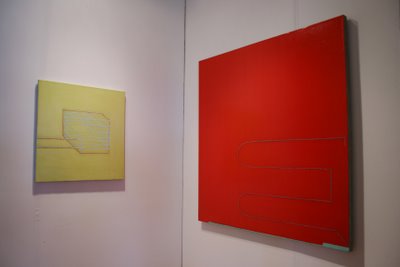
The geometric constructions of Lisa Sigal at Frederieka Taylor are neither painting nor sculpture but flat assemblages composed of layers of paper and tissue and other materials—freeform geometries that are ephemeral but muscular.
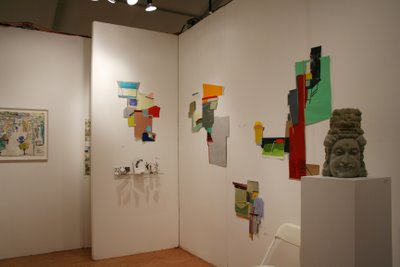 Lisa Sigal at Frederieke Taylor Gallery, New York
Lisa Sigal at Frederieke Taylor Gallery, New York
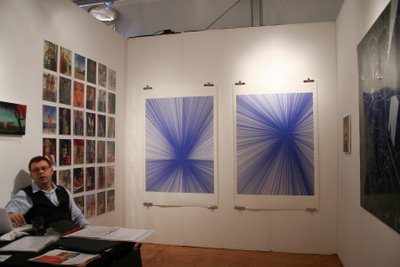
Working blue: Daniel Jackson's 10,000 Lines to a Point at London's Carter Presents, above (that's the dealer, seated); Andrei Molodkin's God is Great at Daneyal Mahmood Gallery, New York

 On the outside wall of the booth, below, you can see the sensuous geometry of Jane Harris. Harris’s show was in the San Francisco gallery when I was there last month. I’ve pulled an image from the gallery’s website so that you can see some of what I saw. Cindy Rucker was working the booth along with Sweetow—that’s Cindy seated. She’s about to open her own gallery on the Lower East Side: Numberthirtyfive (www.numberthirtyfive.com, when the website launches, which should be soon). Good luck, Cindy. Put me on your mailing list!
On the outside wall of the booth, below, you can see the sensuous geometry of Jane Harris. Harris’s show was in the San Francisco gallery when I was there last month. I’ve pulled an image from the gallery’s website so that you can see some of what I saw. Cindy Rucker was working the booth along with Sweetow—that’s Cindy seated. She’s about to open her own gallery on the Lower East Side: Numberthirtyfive (www.numberthirtyfive.com, when the website launches, which should be soon). Good luck, Cindy. Put me on your mailing list! 
Outside the Patricia Sweetow Gallery booth: Jane Harris's twinned geometries, with Cindy Rucker, seated, above; an installation view from Jane Harris's recent show at Patricia Sweetow Gallery, San Francisco
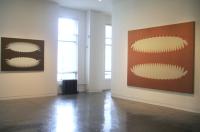
And since I'm on the subject of gallerists, I’m going to close this post with The Proposition’s Ellen Donahue and Ronald Sosinski.  Their booth had a large work by the hot young painter Mickalene Thomas, but for me it was the dealers themselves who stole the show with their his-and-hers patterned suits. "We’ve been in business together over 20 years, and this always happens," said Donahue. And no, she says, "We don’t plan it."
Their booth had a large work by the hot young painter Mickalene Thomas, but for me it was the dealers themselves who stole the show with their his-and-hers patterned suits. "We’ve been in business together over 20 years, and this always happens," said Donahue. And no, she says, "We don’t plan it."
 The pattern at The Proposition: Sartorially resplendent gallery partners Ronald Sosinski and Ellen Donahue, with their assistant
The pattern at The Proposition: Sartorially resplendent gallery partners Ronald Sosinski and Ellen Donahue, with their assistant
Next up: All's Fair: NADA












